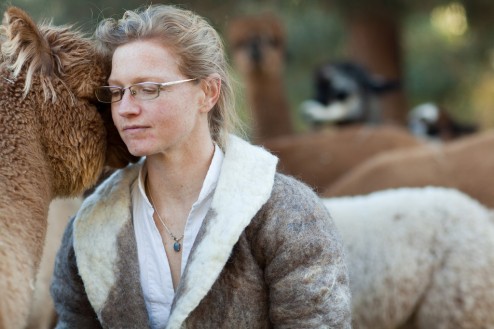Believed to be a gift from Pachamama, the sacred earth mother– alpaca have been present during the rise and fall of many human civilizations from the point of their domestication 6,000 years ago. As the lives of the alpaca and humans became increasingly and intricately woven within ancient South American culture, they became revered and honored for their integral place in pre-Colombian society. The people of the Andes developed an exquisite language of gratitude for the animals who became a vital source of food, fiber, fuel and skins.
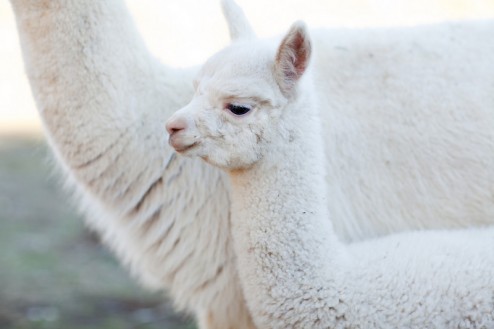
The people and their herds co-existed peacefully until the 1500’s, until the alpaca, like the Incan culture as a whole was met by the invasion of Spanish colonists. The animals were massacred by the millions by militia members who saw them as the linchpin to the Incan empire, and did everything in their power to decimate all aspects of the indigenous culture.
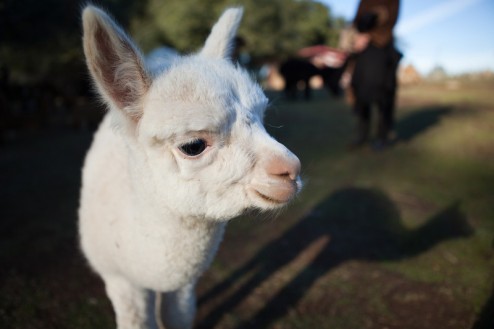
The alpaca were relegated to high mountain plateaus– where they remained safe and protected from modern European weaponry. Today less than 4.9 million alpaca exist. They are a species whose numbers are still recovering from 500 years of history. There are few farms that we have visited within the Fibershed who carry the knowledge and responsibility of this historical narrative like the Rosenfeld family of Mt. Aukum, California.
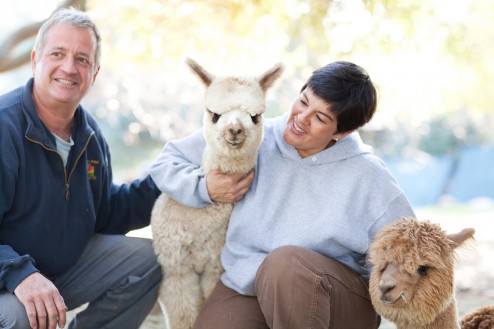
Julie and Ken Rosenfeld are stewards for a most extraordinary flock of alpaca. While visiting their solar-powered ranch in the eastern most stretches of our Fibershed, we were introduced to these four-leggeds–better known as Kachina, Celeste, Blackberry, Guns N’ Roses, and Jesse James (just to name a few). Taking a virtual tour of their herd on the families website, one can see the carefully organized family tree that is the well hewn work of an extensive breeding program.
“It is so important to be making careful breeding decisions that improve the strength of the species. This animal has now, for numerous reasons, been put in our care… we owe it to them to do this right,” said Julie Rosenfeld during our interview.
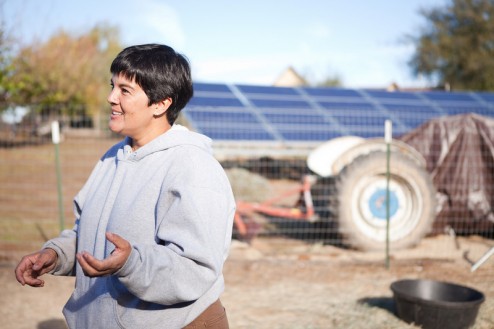
“So often bred for cuteness, or simply for the softest fiber, there must be other considerations that take into account the health of these animals. Too many decisions are made lightly. I’ve seen a lot of herds mismanaged and it is really sad.”
Breeding is about honoring the overall health of the animal, fiber being one facet of the alpaca’s overall genetic make-up. Julie’s husband Ken started his career as an OBGYN in Boston years ago, his original training in the sciences and in the birthing process has assisted the couple’s ability to deal with the complexities of breeding.
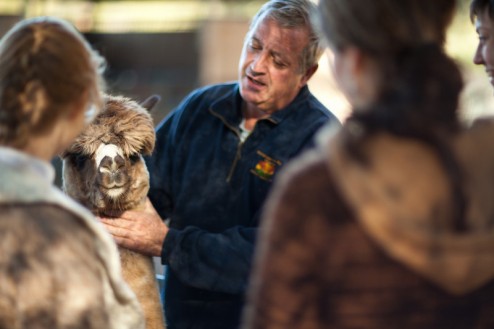
Renaissance Ridge is both a model for good rearing as well as good land management. The electricity for the ranch is generated from a solar grid, the pastures are well covered with organic feed, no signs of erosion or over-grazing exist anywhere. The herd looked perfectly at home standing on the rock studded oak and pine woodlands that make up the topography of Mt. Aukum.

The fiber from this flock averages 17 microns, including the “old gals”, and the “old guys”. This is an above average quality for a herd– and not just slightly above average. When the Rosenfelds had the fiber tested from their male sire- Guns N’ Roses, the follicle density surpassed all internationally documented standards. (This means a lot of fiber per square inch of skin.)
“The beauty of Guns N’ Roses is that all his progeny carry this trait. He has become a household name in the alpaca circles, we share him with a woman on the east coast now. He lives here half time, and travels east to do what he does best.”
Those who raise and rear alpacas are drawn to the work for a multitude of reasons– fine fiber being one of the foremost mentioned…and there is good reason for this– it has become hailed as the “new cashmere” by many in the garment industry. The fiber has a hollow core and few scales, allowing it to be very warm and extremely soft simultaneously. Because it is hypo-allergenic many people are able to wear it who find wool irritating to their skin. The fiber has no lanolin, or “grease” and thus does not have to washed in the way that wool does, saving massive amounts of fresh water resources.
“The other benefit to raising your own alpaca and utilizing their fiber, is to have access to the colored fleeces. Commercial alpaca yarns and garments come from huge herds of white animals, and their fiber is dyed chemically to achieve black, gray, and brown.”
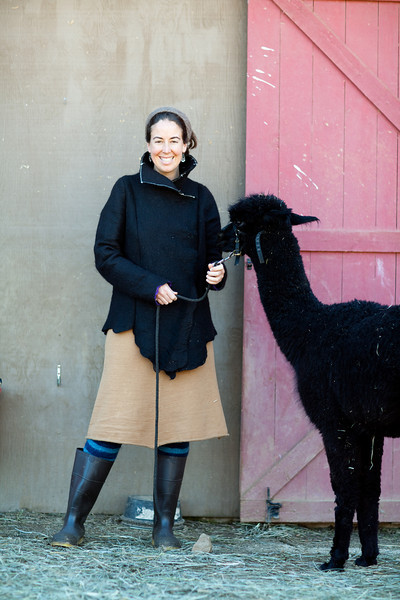
This handcrafted black coat was felted by Katherine Jolda and sewn by Mali Mrozinski. The fiber was generously donated by Blackberry (not pictured), and Tempest (seen above). We wanted to illuminate the stunning options that can be created from the colored fleeces– without utilizing black, gray, and brown chemical dyes. (Synthetic dye applications are typically the most carbon intensive processes of the conventional textile supply chain).
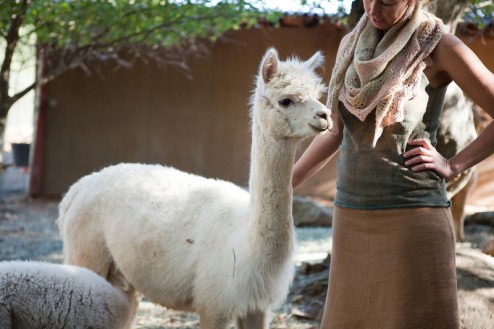
And yet, utilizing non-synthetic and botanic based dyes on the white fleece creates an exquisite foundation for fennel, horsetail, and toyon dye baths, (all naturalized or native species to our California floristic province).
Each of the animals that came close enough to smell the fibers gave the garments a sniff and a nudge– showing signs that there was something familiar in regard to what I was wearing.
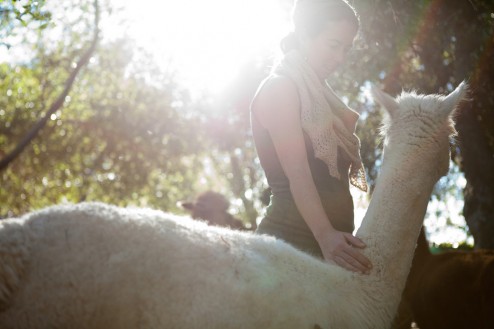
Alpaca fiber has an incredible sheen, it takes the dyes more lightly than wool, and tends to enhance the pastel-like quality of all the botanic colors. The drape that the fiber creates within a finished garment is sought after by those looking to make clothes that will flatter the contours of the human body. The lace weight Victorian-Era inspired shawl (worn in the above picture) was created by Gale Ulvang of San Anselmo. Her work and patterns are featured on Ravelry…. search for “galeu” for more of her knitwear.
We didn’t stop with the lace weight shawl, or jacket… we couldn’t help but to continue to make use of this world class fiber… the experiments continued…
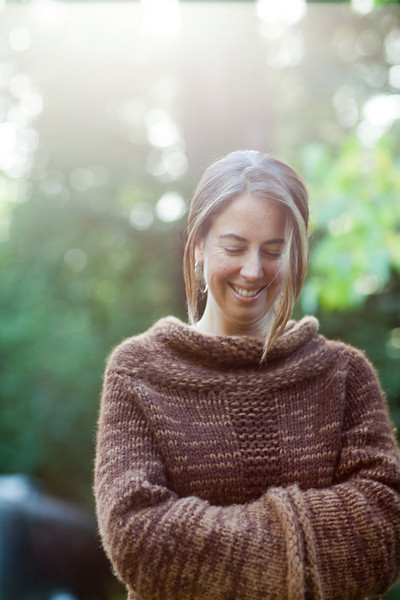 This piece was designed and knit by scientist and knitwear designer Danielle Svehla– no dye work necessary. The carmel and dark brown colors are a product of the natural alpaca fibers. This is the most ideal sweater I could have asked for… it is warm, soft, and purely insulating. The weight of the sweater is what catches you– it is heavy– but that weight is grounding and comforting, like being hugged all day long by Kachina, (the most friendly of all the animals in the flock).
This piece was designed and knit by scientist and knitwear designer Danielle Svehla– no dye work necessary. The carmel and dark brown colors are a product of the natural alpaca fibers. This is the most ideal sweater I could have asked for… it is warm, soft, and purely insulating. The weight of the sweater is what catches you– it is heavy– but that weight is grounding and comforting, like being hugged all day long by Kachina, (the most friendly of all the animals in the flock).
Given how amazingly warm, gorgeous and completely functional this piece has proven to be for me over the last year… we have been inspired to offer the pattern and yarns to all those who want to make their own Fibershed sweater. The intricate details are just now being worked out and the DIY local clothing kit will soon be available in our marketplace.
There is nothing like wearing a garment from an animal that you have be-friended. The reality of the sweater takes shape– it is no longer a layer of cloth next to the skin, but a part of the living, breathing daily life– supporting you, reminding you of your connection to the seasonal, annual and longer life cycles that define you and your engagement with all that lives.
If these animals are beginning to intrigue you… I completely understand– I haven’t been the same since my visit to Renaissance Ridge. Life is different once you cross paths with the alpaca. Their gentle and curious way slows you down and wakes you up in a manner incomparable to other encounters.
If you dream of starting your own alpaca herd… the Rosenfelds are available to answer your questions. They are often called upon to help people discern if alpaca rearing is the right path.
“We consult people all the time about the totality of the alpaca raising process… it is a long life commitment. These animals live for 25 years or more. Their gestation is 11 months. They require a type of care and love that you have to be both passionate and well prepared for. It is a choice we made that has defined our lives completely….I am so happy– for me, this is as good as it gets.”

